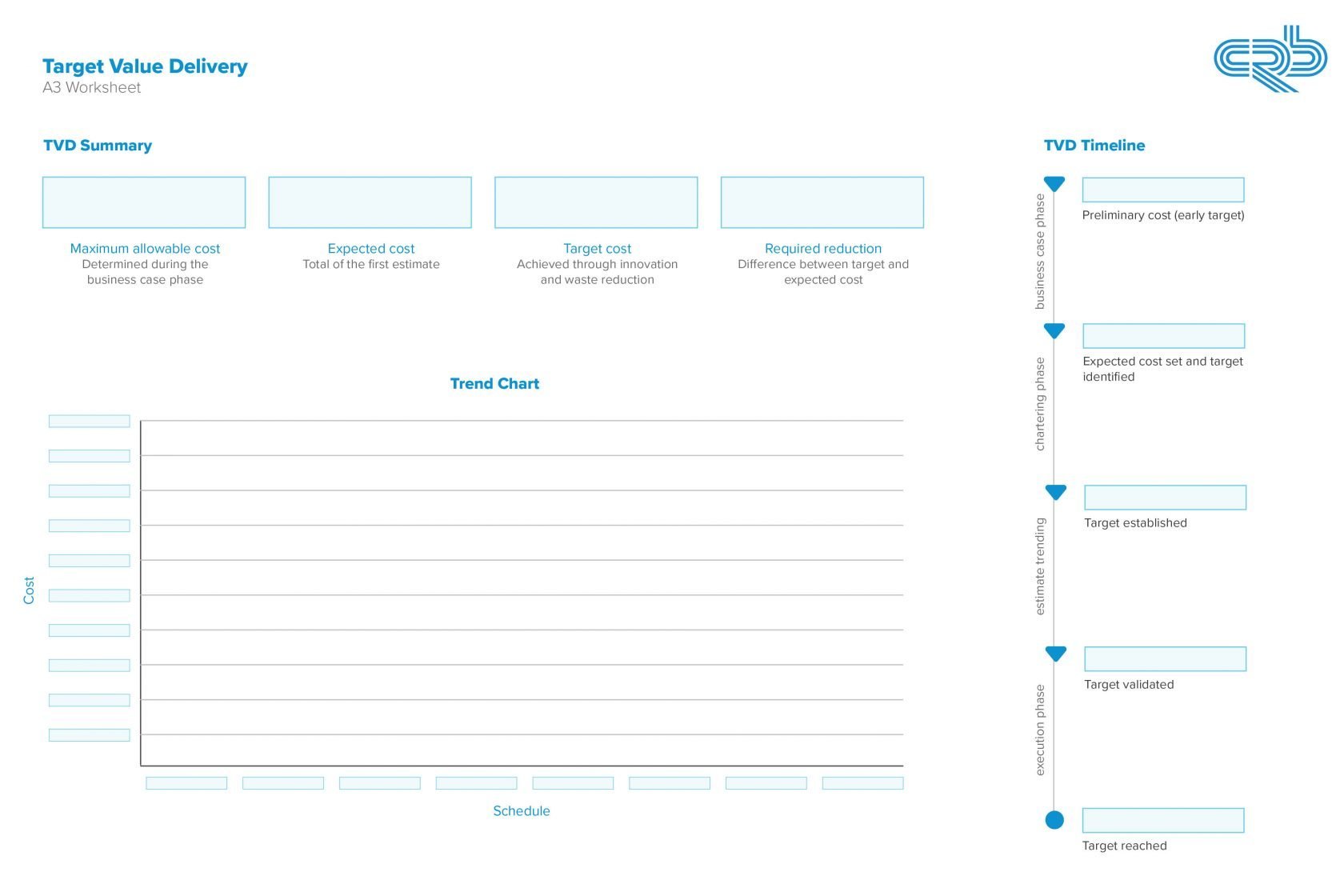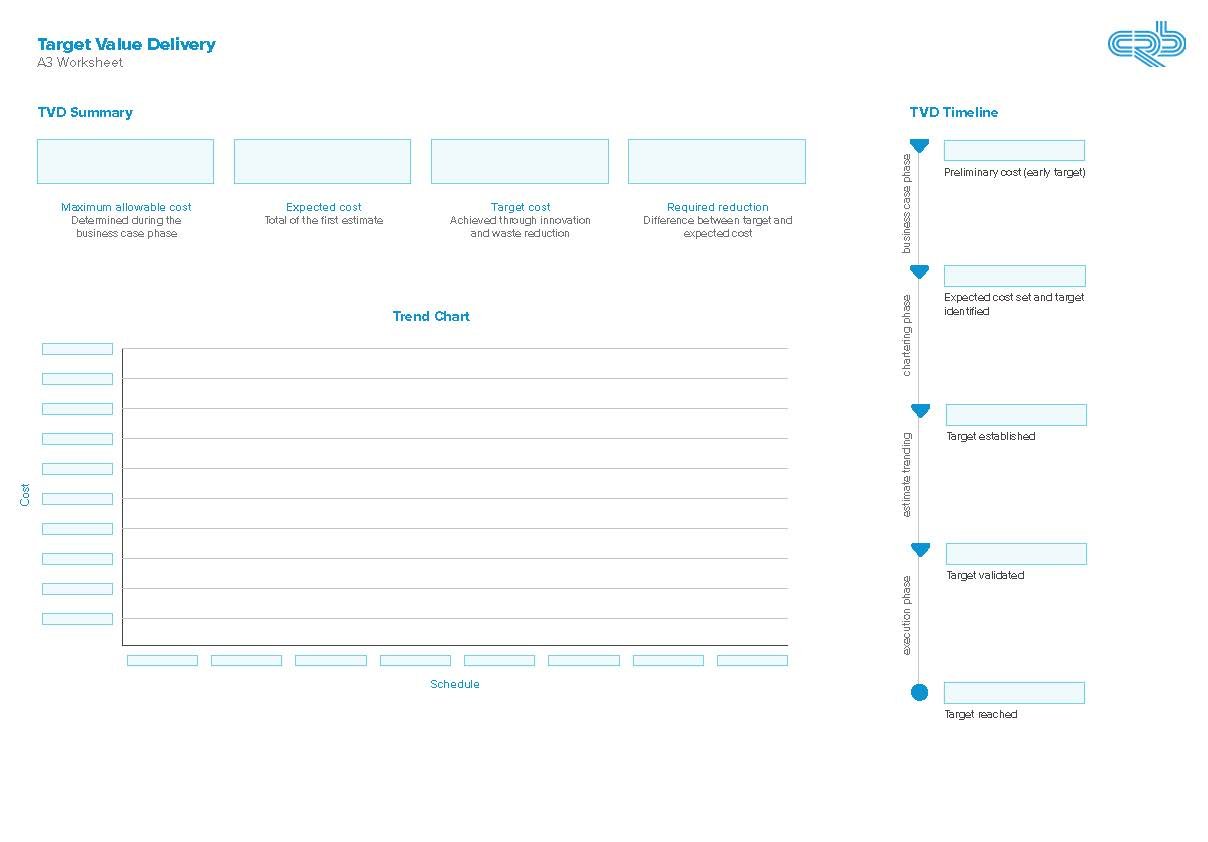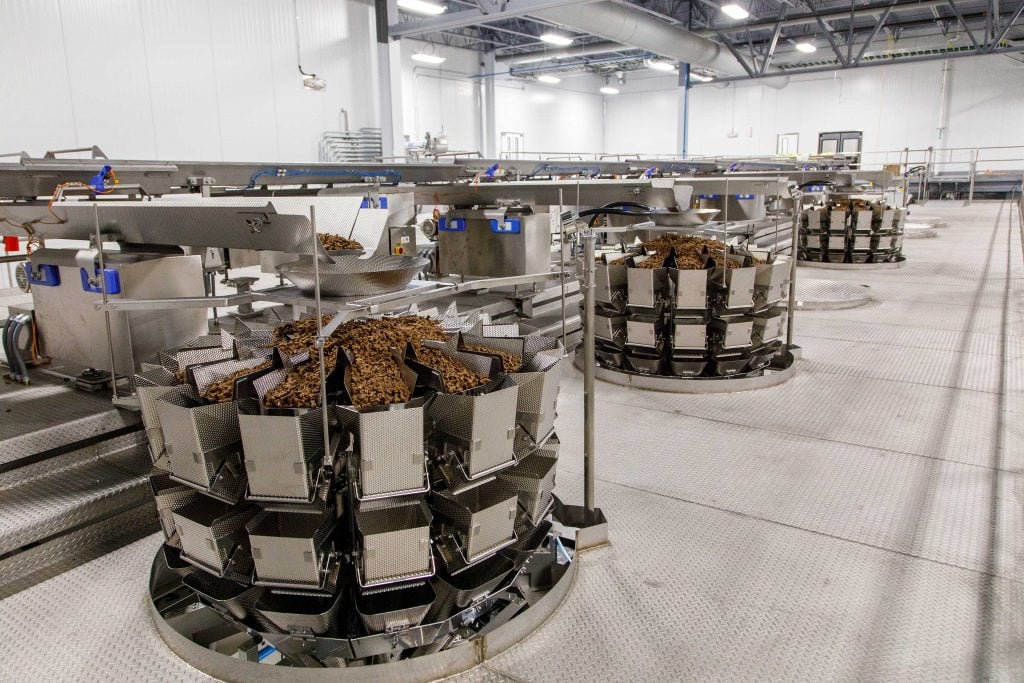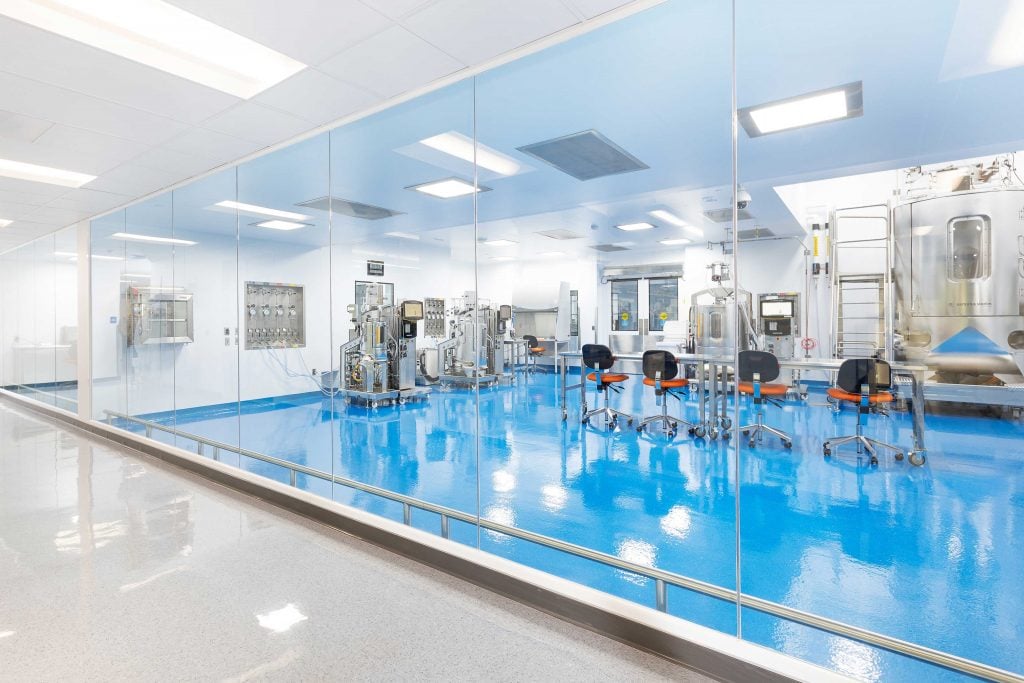Tuffy's Treat Company
Read More
TVD is gaining ground fast with owners, often emerging as a contractual requirement—and for good reason. Why wouldn’t a client want a facility that meets all its needs and doesn’t sacrifice quality or safety—a project that’s on time and under budget? It’s a win for everyone.
Although the concept is straightforward, making TVD work in practice can seem complex for those new to the lean construction movement. It means bringing multiple project partners to the table early in a project’s development. Without this focus on early team integration, TVD can lose traction—and land wide of its target. To get a bullseye, project teams must first get on board with these best practices.
TVD Worksheet Template
1. Ingrain a culture of trust and respect
For project teams to thrive under this model, they need an environment where they can bring innovation and provide creative solutions. Innovation and creativity don’t happen just because you want them to, just as a group of people don’t work well together because you call them a team. It takes conscious effort.
When using TVD, the culture must be proactive, not reactive. All team members should have ownership of the project and have their individual contributions heard and considered. In other words, you want team members to voice their ideas on how a client’s needs could be addressed, not simply revert to the status quo and “see what happens.” This requires project leaders—from the top down—to ensure employees feel emboldened to brainstorm ideas and potential solutions to problems.
TVD is based on lean principles, and respect is the #1 lean principle. If team members feel ideas won’t be received, they’ll retreat to their silos. Remember, for most team members, speaking out and moving away from the status quo is difficult and perceived as risky. The employee will ask, “What’s in it for me?” “Why should I change how I’ve been doing things?”
Think of the TVD concept as giving team members a chance to shine. Work cluster groups are formed across disciplines and may vary by project but could include “scope bucket” clusters with mechanical and plumbing; interior finishes; electrical; foundation and structure; building envelope; framing; drywall; landscape; and millwork, to name a few. Each cluster “owns” the scope for their group and should include client representatives, trade partners, vendors, and professionals from design and construction. It may seem like “too many cooks in the kitchen,” but those “cooks” fuel cost certainty—and if they have the right tools, applied within the right team culture, then “too many” can feel like “just enough.”
2. Use TVD at every project phase
There are three phases of target value delivery and some fundamentals to keep in mind for each.
The business case alignment phase
The business case alignment phase, sometimes referred to as the feasibility phase, is the first phase in a ONEsolution project. The goal: to understand what the client needs and wants and, based on their budget, decide if those “wants” are within scope or out-of-scope. Use historical data from previous projects as well as supply and labor estimates to help “ballpark” the project, aligning on budget and scope as early as possible.
In this phase, strive to spend the minimal amount of time and money to reach alignment with the client, answering the questions: What scope does your budget allow? What do you value/need?
Value vs. cost: Value is the expected outcome a client receives from the design and construction process, along with the benefit of the facility. Value is the main driver of TVD, but cost plays an equally important role. Value and cost must work in tandem. After all, if you pay less for something but it doesn’t give you the value you need, it ends up costing you—one way or another.
For example, assess whether the project needs automated processes or if manual is acceptable. If automation is a need, will the budget cover the cost? This phase is a general deciphering of what’s in and what’s out.
During this phase, zero-based scoping (ZBS) helps the team understand exactly what the client wants. This is all done with input from trade partners, vendors, designers, estimators, and the client. With ZBS, every project gets a clean slate budget-wise, and each expense is justified (instead of defended). “We’ve always done it this way” doesn’t warrant an automatic allocation.
The end goal of this phase is to determine viability of the project, including setting a maximum allowable cost and conditions of satisfaction.
The importance of ZBS: Zero-based scope (ZBS), sometimes referred to as zero-based budgeting is a cost discipline methodology that starts the budget at zero and adds each scope component building the budget as each value or need is addressed. The name doesn’t at all imply zero or low quality. It’s simply an innovative strategy to discard what the client doesn’t need and allocate money to what they do. ZBS is one of the best tools to ensure TVD success because it helps teams make qualitative design decisions with cost as an input.
The chartering phase
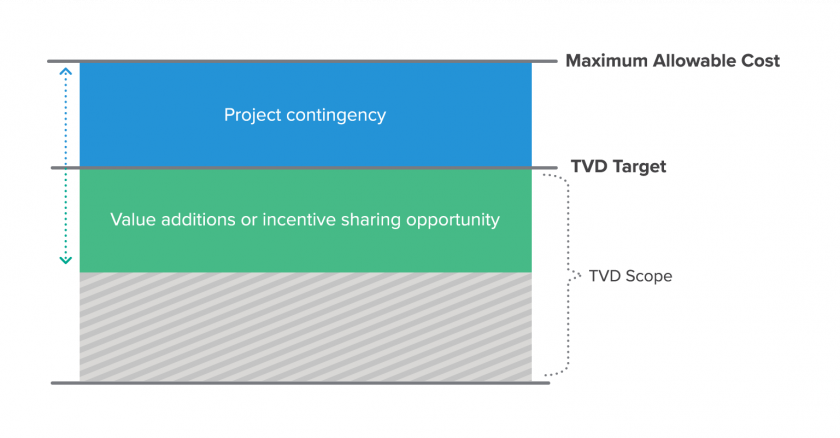
Figure 1. The TVD target includes the owner’s cost and potential risk/reward incentive amount. The TVD target is lower than the maximum allowable cost which includes project contingency.
Once the business case alignment phase determines the project is viable, you’ve entered the “chartering” phase, where project team members work toward arriving at a target cost. The name of this phase is often used interchangeably with “concept” phase. The target cost includes the owner’s cost, as well as a risk/reward contingency (Figure 1). This will be lower than the “allowable cost,” which is the maximum the client can spend. The project team should co-author a project charter, which lays out the project goals, target value, and the client’s conditions of satisfaction. The charter is a road map for the team and ensures early alignment between the project owner and the project team.
If the business case alignment phase is where you designate scope and viability, the chartering phase is where you flesh out the specifics. If the client must have automation, for example, decide what level of automation.
With TVD, since the “value” (what the client wants) is the driver, cost is a constraint (if you pull back on this feature, you can add this “wish list” item).
The chartering phase is also when concept design takes place. All quantities and costs should be established as early as possible to avoid surprises. When that’s not feasible, TVD practices help establish predictive quantity estimates. Good communication between designers, estimators, and key trade partners is critical for this step. The team should also identify the minimum amount of scope necessary to prevent overwork and unnecessary costs.
So, how do you determine overall costs so early? It’s all about specifics.
Quantify as early as possible using:
- Point maps
- P&ID assembly diagrams (PADs)
- Equipment lists
- Area tabs or area summary single lines
ZBS tools help drill down to specifics. For example, if you determined during feasibility that the client wants six fixed bioreactors, that’s the quantity, but now you need to qualify: Will they be stainless steel or Hastelloy? By determining the cost differential and applying TVD methodologies, you maintain transparency in cost impact and allow for greater cost certainty.
A word on estimating: it’s continuous, and changes can occur because of the supply chain, availability of vendors, and even the changing of client goals. Estimating is happening intentionally throughout the project.
The execution phase
TVD is not just for the design phases. That’s why it’s called target value delivery instead of target value design. Target value delivery is the term you want. “Delivery” and “design” are often used interchangeably, but “delivery” is holistic and encompasses the finished product—not just its design phase.
With the target value set, the execution phase begins. The key here is communication regarding the progress made, including any changes that deviate from the concept phase. Software tools, like a TVD dashboard (Figure 2), help work cluster groups maintain the target cost throughout the project. Execution requires continuous communication, collaboration and coordination of all team members.
The TVD strategy guides these decisions according to the value input from the client. For example, a client may choose a lower-cost flooring if it means an extra feature for a piece of equipment. Getting those details early saves time and prevents costly redesign. After all, it’s a lot more work to decrease costs by deconstructing after the fact. It makes a lot more sense to align early. As the saying goes, “the devil is in the details.”
The terminology makes an important distinction between traditional project delivery and lean methodologies. The traditional process (target value design) prioritizes design as a cost driver, dictating that designers need to know what they’re building before determining costs. Today’s process (target value delivery) makes cost, value and constructability the drivers of design. This flips the paradigm, meaning we start with the amount a project owner can spend. This approach is replacing the old way of working, making it possible to deliver a project that’s under budget without sacrificing value.


Figure 2. The TVD dashboard gives a high-level look at how each work cluster is tracking towards the overall target value.
3. Continuously track and trend
At the end of the concept phase, you should have the target cost set. About 2% of the total installed cost is spent and 15% of the total schedule elapsed. Throughout the project, continuously track to that to meet it at the end of the project—hopefully with additional savings.
The key to cost certainty is diligence—and vigilance—when it comes to tracking potential risks and trending costs. The trend log (Figure 3) is an important tool in the TVD process. Since each work cluster group “owns” their scope bucket, members can make quick, informed decisions without having to reach very far to collaborate.
What is a TVD trend log?: It’s much like a traditional scope variance log with two major differences: it’s an inclusive document, and it’s a decision-making tool. As scope is added or removed, it’s captured on the log, and the entire team can see the budget and must offset their own scope buckets as needed. Team members notify cluster group leaders when a change is made to ensure the TVD Facilitator updates the entire trend log.
When tracking, team members should show their work. Everything is transparent, and it’s important the client design leads understand new predictions and why they changed.
The TVD trend log is centralized, accessible data that allows team members visibility into the project, so changes and decisions align with micro goals (for work clusters) and macro goals for the client’s conditions of satisfaction.
What is a TVD facilitator?: The TVD facilitator is the hub of the process and drives the value culture on the project. They manage the flow of information to the project team, coordinates and collaborates within the team and stakeholders, and ensures work cluster leads report changes in scope buckets to update the TVD log.


Figure 3. The TVD trend log is used to track scope variance and evaluate whether or not to make changes.
There’s a push-pull effect here, too. Let’s say an owner wants to make changes that push past the target cost. Through collaboration, team members should look for opportunities to offset the cost impact to bring the project back within target while still meeting the original satisfaction requirements of the owner, so we do not sacrifice value.
Team members should add changes as soon as possible to the TVD trend log, regardless of how small, even a schedule change or a delay in materials. It’s critical to communicate any changes from the baseline assumptions to work cluster group leads, the TVD facilitator, designers, and estimators. The TVD trend log keeps everyone in the loop. Communication is vital in the TVD journey.
The way to the TVD bullseye
When you’ve aligned the target cost with the customer’s value, you’ve hit the bullseye of target value delivery. Any deviation from that target cost must be elevated to the client’s steering committee. Essentially, it’s a change to the business case. The final say rests with the project sponsor, who decides whether a change in the target cost is justified.
Download our one-page TVD worksheet to chart basic values and cost parameters to better understand how your project could be a target value delivery success.


